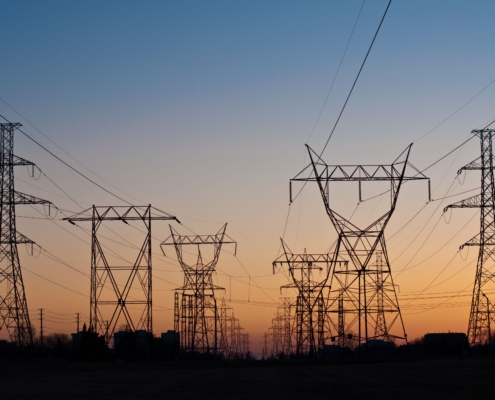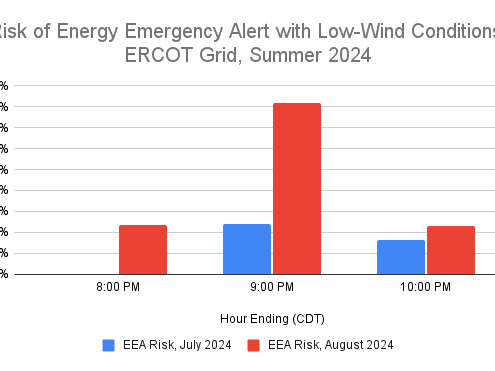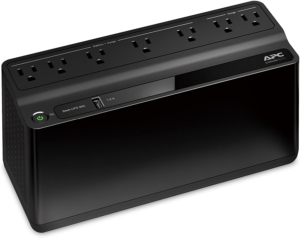Last Updated on November 17, 2022 by Mary Pressler
The Difference Between Brownouts and Blackouts
What is a Blackout?
A blackout is a complete interruption of the power supply, and all appliances and equipment that depend on electricity are deactivated.
What is a Brownout?
An electricity brownout is different than a blackout. In a brownout, the voltage provided by the power supply drops below its standard value, but the electric service is not interrupted completely.
Reduced voltage may seem better than having no voltage, but brownouts can be worse than blackouts in many cases. Electrical devices are designed for a specific voltage range, and they may suffer damage when exposed to a voltage that is too high or too low. This risk is not present during a blackout, since there is no voltage at all.
What Is the Difference Between a Brownout and a Voltage Sag?
In some buildings, you may have noticed that the lights dim down for a few seconds when a large motor activates. For example, this may happen when starting a central air conditioner or a centrifugal pump. These quick voltage drops that only last for a few seconds are called sags.
When starting an electric motor, the inrush current can be 5 to 8 times higher than the normal current, and this will cause a voltage sag if the motor is large. Electrical engineers recommend inverter drives, which start motors by ramping up the voltage gradually, instead of applying the full voltage at once. This starting method reduces the inrush current, eliminating sags.
A brownout is an extended event, on the other hand, lasting for several minutes or even hours. When a building is affected by a brownout, the cause can be external or internal:
- When a brownout affects a large area, the most likely cause is a power grid overload. The voltage drops because electricity generation cannot keep up with consumption, and electric companies may also lower the voltage intentionally to reduce power demand.
- Brownouts that affect individual buildings are clear warning sign of electrical issues. For instance, if too many appliances share the same circuit, the resulting overload can cause a localized brownout.
When a brownout is due to external causes, you should focus on protecting your electrical devices. On the other hand, if the brownout cause is inside your property, you can get an electrical inspection to find a solution.
Which Devices Are Most Vulnerable to Power Failures?
The effects of brownouts are not the same for all electrical appliances. Incandescent lights are only dimmed without damage, and actually that is where the term “brownout” comes from. The effect is similar for resistance heaters, which experience a reduction of their heat output.
Other devices are more vulnerable to brownouts, in particular those with electric motors or electronic components:
- Electric motors are very susceptible to low voltage, since it causes them to draw more current and overheat. A motor that is constantly exposed to low voltage will suffer a drastic reduction of its service life.
- Electronic components can also suffer damage with low voltage. Even if there is no damage, a brownout can cause incorrect operation by altering the voltage pulses used in control signals.
Electricity companies are aware of the negative effects of brownouts. When they are caused intentionally, the decision is a last resort to prevent infrastructure damage or major blackouts.
In general, you should avoid exposing your electrical appliances to brownouts, especially those appliances with motors or electronic components. You can do this by installing a brownout protection device called an UPS.
Protecting Your Appliances from Brownouts
Just like a circuit breaker protects against excessive current, an undervoltage relay can disconnect your devices when the voltage drops too much. However, these relays are only recommended for sensitive appliances, since they add costs to your electrical installations.
Uninterruptible power supplies (UPS) often have voltage regulation capacity, and they can keep a stable voltage output even when the voltage supply from the power grid fluctuates. UPS devices are normally used to ensure a stable power source for critical devices, such as data centers that host important applications.
Installing many under-voltage relays and UPS units at home can be very expensive. These measures are normally used only for sensitive devices and critical applications. Many home devices are controlled with switches, and leaving them in the OFF position provides effective protection against brownouts.
Some electronic devices remain in a “standby” mode when not in use, and they are vulnerable to brownouts unless they are unplugged. You can connect several electronic devices to a power strip with a switch, and disconnect them all at once when a brownout occurs.
Share this entry
 https://quickelectricity.com/wp-content/uploads/2024/07/Lubbock-Electricity-Bill-Explained-scaled.jpg
1360
2048
Mary Pressler
https://quickelectricity.com/wp-content/uploads/2021/10/Quick-Electricity-Logo--300x79.jpg
Mary Pressler2024-07-21 08:55:502024-07-23 20:14:08Your Lubbock Electricity Bill Explained
https://quickelectricity.com/wp-content/uploads/2024/07/Lubbock-Electricity-Bill-Explained-scaled.jpg
1360
2048
Mary Pressler
https://quickelectricity.com/wp-content/uploads/2021/10/Quick-Electricity-Logo--300x79.jpg
Mary Pressler2024-07-21 08:55:502024-07-23 20:14:08Your Lubbock Electricity Bill Explained https://quickelectricity.com/wp-content/uploads/2024/06/Risk-of-Energy-Emergency-Alert-with-Low-Wind-Conditions-ERCOT-Grid-Summer-2024.png
371
600
Mary Pressler
https://quickelectricity.com/wp-content/uploads/2021/10/Quick-Electricity-Logo--300x79.jpg
Mary Pressler2024-06-26 09:47:422024-06-26 09:47:42Texas Electricity Outlook Summer 2024
https://quickelectricity.com/wp-content/uploads/2024/06/Risk-of-Energy-Emergency-Alert-with-Low-Wind-Conditions-ERCOT-Grid-Summer-2024.png
371
600
Mary Pressler
https://quickelectricity.com/wp-content/uploads/2021/10/Quick-Electricity-Logo--300x79.jpg
Mary Pressler2024-06-26 09:47:422024-06-26 09:47:42Texas Electricity Outlook Summer 2024 https://quickelectricity.com/wp-content/uploads/2022/08/Texas-Electricity-Broker-.png
1080
1080
Mary Pressler
https://quickelectricity.com/wp-content/uploads/2021/10/Quick-Electricity-Logo--300x79.jpg
Mary Pressler2024-06-18 16:14:522024-06-22 08:43:08Commercial Energy Broker in Texas
https://quickelectricity.com/wp-content/uploads/2022/08/Texas-Electricity-Broker-.png
1080
1080
Mary Pressler
https://quickelectricity.com/wp-content/uploads/2021/10/Quick-Electricity-Logo--300x79.jpg
Mary Pressler2024-06-18 16:14:522024-06-22 08:43:08Commercial Energy Broker in Texas https://quickelectricity.com/wp-content/uploads/2024/05/Electricity-Options-Texas.jpg
627
1200
Kelli
https://quickelectricity.com/wp-content/uploads/2021/10/Quick-Electricity-Logo--300x79.jpg
Kelli2024-05-14 04:05:352024-05-14 04:05:35Demystifying Energy Contracts: What Texans Need to Know
https://quickelectricity.com/wp-content/uploads/2024/05/Electricity-Options-Texas.jpg
627
1200
Kelli
https://quickelectricity.com/wp-content/uploads/2021/10/Quick-Electricity-Logo--300x79.jpg
Kelli2024-05-14 04:05:352024-05-14 04:05:35Demystifying Energy Contracts: What Texans Need to Know https://quickelectricity.com/wp-content/uploads/2024/04/How-to-Cut-Monthly-Expenses.jpg
412
618
Mary Pressler
https://quickelectricity.com/wp-content/uploads/2021/10/Quick-Electricity-Logo--300x79.jpg
Mary Pressler2024-04-21 16:36:072024-04-21 16:37:27How to Cut Monthly Expenses: 9 Clever Ways to Save Money
https://quickelectricity.com/wp-content/uploads/2024/04/How-to-Cut-Monthly-Expenses.jpg
412
618
Mary Pressler
https://quickelectricity.com/wp-content/uploads/2021/10/Quick-Electricity-Logo--300x79.jpg
Mary Pressler2024-04-21 16:36:072024-04-21 16:37:27How to Cut Monthly Expenses: 9 Clever Ways to Save Money https://quickelectricity.com/wp-content/uploads/2019/10/Frontier-Utilities-LOGO.png
800
800
Mary Pressler
https://quickelectricity.com/wp-content/uploads/2021/10/Quick-Electricity-Logo--300x79.jpg
Mary Pressler2024-03-20 13:44:022024-03-20 13:46:02Texas 24 Month Energy Plans
https://quickelectricity.com/wp-content/uploads/2019/10/Frontier-Utilities-LOGO.png
800
800
Mary Pressler
https://quickelectricity.com/wp-content/uploads/2021/10/Quick-Electricity-Logo--300x79.jpg
Mary Pressler2024-03-20 13:44:022024-03-20 13:46:02Texas 24 Month Energy Plans https://quickelectricity.com/wp-content/uploads/2024/03/How-to-improve-energy-efficiency-in-buildings.png
980
1470
Mary Pressler
https://quickelectricity.com/wp-content/uploads/2021/10/Quick-Electricity-Logo--300x79.jpg
Mary Pressler2024-03-08 09:33:152024-03-08 09:39:41Improving Energy Efficiency in Buildings
https://quickelectricity.com/wp-content/uploads/2024/03/How-to-improve-energy-efficiency-in-buildings.png
980
1470
Mary Pressler
https://quickelectricity.com/wp-content/uploads/2021/10/Quick-Electricity-Logo--300x79.jpg
Mary Pressler2024-03-08 09:33:152024-03-08 09:39:41Improving Energy Efficiency in Buildings https://quickelectricity.com/wp-content/uploads/2024/02/Water-Conservation-and-Energy-Efficiency.jpg
788
940
Mary Pressler
https://quickelectricity.com/wp-content/uploads/2021/10/Quick-Electricity-Logo--300x79.jpg
Mary Pressler2024-02-28 08:06:552024-03-12 09:23:09An Eco-Friendly Approach to Water Conservation
https://quickelectricity.com/wp-content/uploads/2024/02/Water-Conservation-and-Energy-Efficiency.jpg
788
940
Mary Pressler
https://quickelectricity.com/wp-content/uploads/2021/10/Quick-Electricity-Logo--300x79.jpg
Mary Pressler2024-02-28 08:06:552024-03-12 09:23:09An Eco-Friendly Approach to Water Conservation https://quickelectricity.com/wp-content/uploads/2024/02/Energy-Efficient-Home-Designs-Windows-.jpg
788
940
Mary Pressler
https://quickelectricity.com/wp-content/uploads/2021/10/Quick-Electricity-Logo--300x79.jpg
Mary Pressler2024-02-08 11:39:572024-02-08 11:44:26Designing an Energy Efficient Home in 2024
https://quickelectricity.com/wp-content/uploads/2024/02/Energy-Efficient-Home-Designs-Windows-.jpg
788
940
Mary Pressler
https://quickelectricity.com/wp-content/uploads/2021/10/Quick-Electricity-Logo--300x79.jpg
Mary Pressler2024-02-08 11:39:572024-02-08 11:44:26Designing an Energy Efficient Home in 2024
